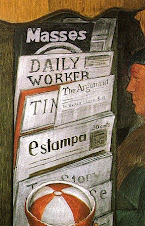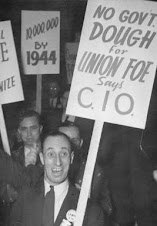.JPG)
By Fred Goldstein
Published Sep 1, 2010 7:32 PM
It is now the beginning of the fourth year since the housing bubble burst in August 2007, leading to the worst economic crisis since the Great Depression. Record amounts of money, reaching into the trillions of dollars, have been spent by the capitalist government — most of it in handouts to the banks to keep the economy from collapsing altogether.
But after the bailouts to the banks and corporations, a $787 billion stimulus package and a year of so-called “recovery,” 25 million to 30 million workers remain unemployed or in need of more hours just to survive. And now the threat of a so-called “double dip” looms on the economic horizon.
The term “double dip” is a harmless-sounding way the bosses’ economists have of describing a coming new disastrous wave of layoffs and cutbacks for the working class. It refers to the lines on their charts that go up and down with production.
In the first “dip,” according to government statistics, at least 8 million workers lost their jobs; millions more dropped out of the job market and millions more looking for their first job could not find work. During this first “dip,” 2.3 million people lost their homes to foreclosure. Evictions are growing but their number has not been reported. More than 1.4 million workers who have been out of work for more than 99 weeks have lost their unemployment benefits. More than 6 million workers have now been unemployed for more than 6 months.
State and local budgets have been cut to the bone as banks demand their interest payments. Government workers are being laid off, furloughed and forced to take pay cuts. Schools have been shut, hospitals closed and fire departments shut down while billions of dollars are being cut from the food stamp program and millions of people have flooded into welfare programs.
Youth unemployment is at record numbers. In July, 51.1 percent of workers between the ages of 16 and 24 were unemployed. African-American, Latino/a and Asian youth have been hit hardest.
Overall, in July there were five unemployed workers for every job opening available. In other words, there were no jobs at all for 80 percent of the 15 million officially unemployed workers.
No economic revival in sight
This is what the capitalist “recovery” has looked like. It has been a profit recovery for the capitalists and a jobless recovery for the workers.
As bad as it has been for the workers, statistics show that after a year of government attempts to pump up a failing capitalist system, economic growth is declining, investment is declining, lending is declining, and the economy is headed for a new contraction.
This is a strong indication that the system as a whole has reached a failed state. The times when capitalism bounced back after a crisis may very well be a thing of the past. Workers should not expect things to revive on their own.
While the bosses are worrying about how many millions and billions of dollars they will have left after another crisis, the workers — even those who still have jobs — need to worry about survival.
The only way to survive another crisis is to stop the bosses from unloading it onto our backs.
Bosses on a hiring strike
The capitalists are on a hiring strike. They won’t hire. They are sitting on $1.8 trillion in cash, but they refuse to invest because they’re worried that they won’t make a profit, even though last year their profits amounted to $1.2 trillion, more than they were raking in before the crisis.
Every nickel of that money represents wealth created by the workers. It ends up in the hands of the capitalists because they own all the factories, offices, mines, stores and the rest of the economy.
How did the bosses “recover” from the first phase of this crisis? Not by creating new industries or expanding existing industries. They recovered their profits by laying off workers, cutting wages and speeding up those who were left on the job.
Take the auto industry, which is central to the economy. It came back to life when General Motors, Ford and Chrysler shut down dozens of plants, laid off hundreds of thousands of workers and forced two-tier contracts on the union, so that new hires now earn only $14 an hour. Other industries shrank their operations in similar fashion.
Profitability was restored by getting more and more production out of fewer and fewer workers, who were paid lower wages. If you do the math, it is a fairly easy capitalist equation. Produce more and more. Lay off more and more. Cut wages more and more.
But then what happens? Soon you cannot sell any more at a profit because the workers are broke. Then come more layoffs and shutdowns. This is the way capitalism works.
The working class, the communities, the youth and students need a program to combat the threat of a renewed crisis. There must be a fight for a moratorium on layoffs, shutdowns and wage cuts.
There can be a struggle for a shorter workweek at no cut in pay. And there can be a campaign to force the government in Washington to implement a jobs program — like the Works Progress Administration, which provided jobs for 8 million workers during the Great Depression.
Demand a government jobs program
The government has trillions of dollars. If it can spend $1.25 trillion to buy toxic assets from the banks, it can spend that much to create a jobs program so that every unemployed worker can get a government-created job. Right now the Federal Reserve is planning to spend $1 trillion buying government bonds. Instead, that trillion should go to a direct jobs program.
We can get it, but only if we fight for it.
A national jobs program, open to all the unemployed, could carry out the multitude of tasks that the profit system has left undone. It could also initiate new programs. The government could use the existing skills of workers and provide training in new skills.
Demand shorter workweek, no cut in pay
By not hiring, the bosses and bankers are carrying out a virtual general strike of capital against labor. When workers go on strike, the bosses get injunctions, hire scabs and starve workers out in a war against our class.
It is high time for workers to fight to get their jobs back, to stop the layoffs and workplace closings and see that everyone who needs a job has one, at a living wage with full benefits.
Workers have to insist that a job is a right. The bosses say they cannot hire because there is no work. But since they have found ways to increase production, it is only just that the workers should benefit from this. If the workweek were reduced with no reduction in pay, then workers could benefit from the increased revenue.
The increased revenue should be used to add jobs and shifts instead of increasing profits. Millions of workers could be put to work under such a formula. Workers would have paychecks and could buy what they need.
The labor movement should revive and fight for some version of the old union slogan, “30 for 40,” meaning 30 hours’ work for 40 hours’ pay.
Articles copyright 1995-2010 Workers World. Verbatim copying and distribution of this entire article is permitted in any medium without royalty provided this notice is preserved.











































No comments:
Post a Comment